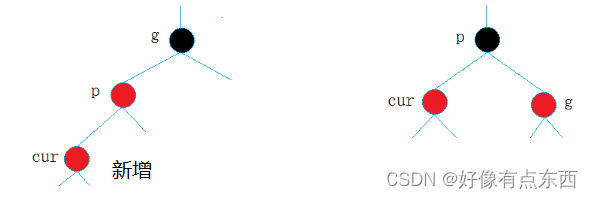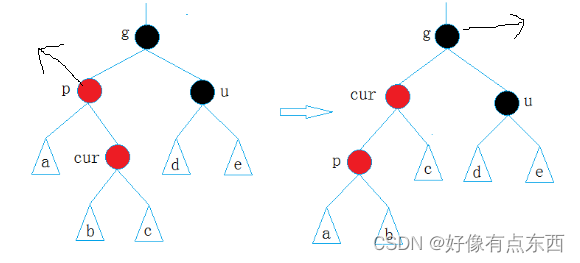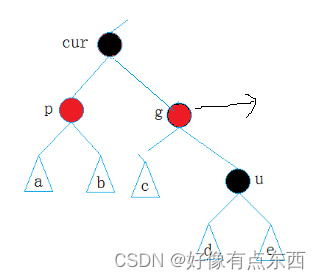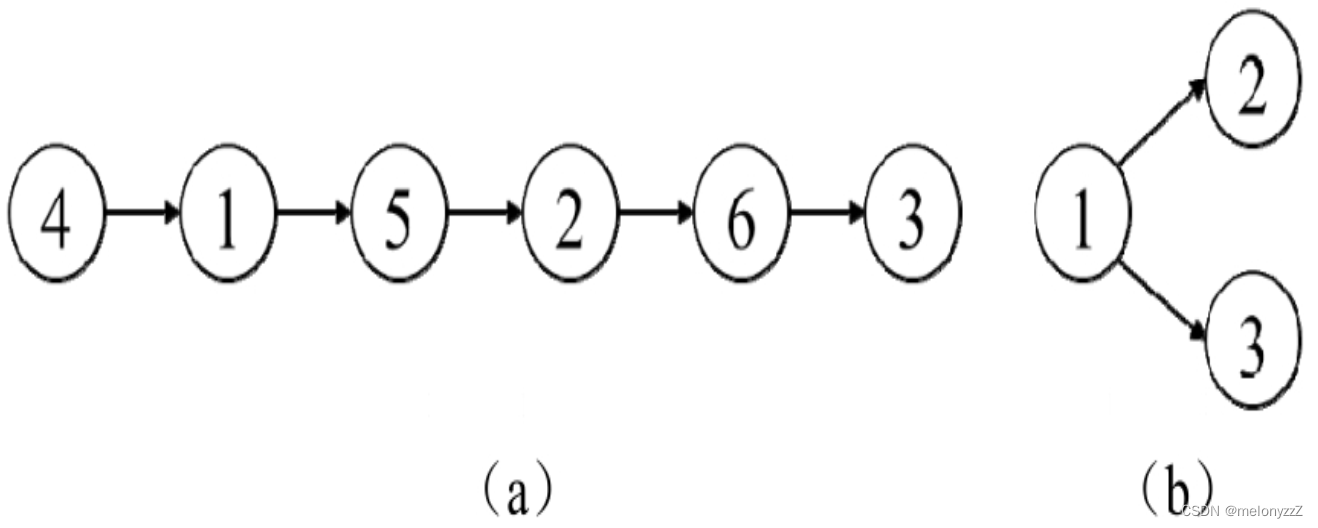目录
一、红黑树
1.1 基本概念
1.2 红黑树与AVL树的比较
二、结构和操作
2.1 节点定义
2.2 节点的插入操作
2.3 红黑树的迭代器
2.4 红黑树的模拟实现
三、set、 map的模拟实现
一、红黑树
1.1 基本概念
红黑树是一种二叉搜索树,但在每个结点上增加一个存储位表示结点的颜色,可以是Red或
Black。

红黑树满足以下性质:
- 节点颜色:每个节点要么是黑色,要么是红色。
- 根节点:根节点是黑色。
- 颜色限制:如果一个节点是红色的,则它的子节点必须是黑色的(不存在两个连续的红色节点)。
- 叶子节点:每个叶子节点(NIL 节点,即空节点)都是黑色的。
- 黑节点数量:对于每个节点,从该节点到其后代叶子节点的简单路径上,黑色节点的数量是相同的。
这些性质保证了红黑树的关键特性:任何从根到叶子的路径上,最长的路径不会超过最短路径的两倍长。因此,红黑树是一种高效的自平衡二叉搜索树,适用于需要频繁插入、删除和查找操作的场景。
注:
- 最短路径和最长路径不一定会存在。
最短路径:全黑
最长路径:一黑一红间隔 - 假设每条路径都有N个黑色节点,每条路径的节点数量在[N,2*N]之间。
1.2 红黑树与AVL树的比较
红黑树和AVL树都是自平衡二叉搜索树,但它们在平衡策略和性能方面有所不同。
平衡性:AVL树是严格平衡的,它要求左右子树的高度差不超过1。而红黑树是近似平衡的,它通过染色和旋转来维护平衡,允许最长的路径不会超过最短路径的两倍长。相对而言,红黑树的平衡性要稍弱一些,但仍然能够在大多数情况下保持较好的平衡。
插入和删除操作的效率:由于AVL树是严格平衡的,因此插入和删除操作可能需要进行更多的旋转来调整树的结构,以维持平衡。相比之下,红黑树的插入和删除操作可能需要更少的旋转操作,因为它允许一定程度的不平衡。因此,红黑树在插入和删除操作方面可能具有更好的性能。
查询操作的效率:由于红黑树在插入和删除操作上具有更好的性能,但在查询操作上与AVL树相当。这是因为红黑树的高度相对较大,但仍保持在较小的范围内,使得查询操作的时间复杂度仍然是O(log n),其中n是树中节点的数量。而AVL树由于严格的平衡性要求,在某些情况下可能会略微优于红黑树。
二、结构和操作
2.1 节点定义
enum Colour
{RED,BLACK
};template <class T>
struct RBTreeNode
{RBTreeNode<T>* _left;RBTreeNode<T>* _right;RBTreeNode<T>* _parent;T _data;Colour _col;RBTreeNode(const T& data):_left(nullptr),_right(nullptr),_parent(nullptr),_data(data),_col(RED){}
};2.2 节点的插入操作
按照二叉搜索的树规则插入新节点,新节点是红色,有两种情况:
1、插入节点的父亲是黑色,那么就结束了。没有违反任何规则。
2、插入节点的父亲是红色的,那么存在连续的红色节点,违反规则3,需要处理。
设新插入的节点为cur,其父亲节点为p,祖父节点为p,叔叔节点为u,根据各节点颜色的不同可分为以下几种情况:
情况1:cur为红,p为红,g为黑,存在且为红
解决方式:将p,u改为黑,g改为红,然后把g当成cur,继续向上调整。
注意:此处所看到的树,可能是一棵完整的树,也可能是一棵子树
情况二:cur为红,p为红,g为黑,u不存在
解决方案:若p为g的左孩子,cur为p的左孩子,则g进行右单旋转;
相反,p为g的右孩子,cur为p的右孩子,则g进行左单旋转;
p、g变色--p变黑,g变红

情况三:cur为红,p为红,g为黑,u存在且为黑
c为包含一个黑色节点红黑树
解决方案:旋转+变色
若p为g的左孩子,cur为p的左孩子,则g进行右单旋转;
相反,p为g的右孩子,cur为p的右孩子,则g进行左单旋转;
p、g变色--p变黑,g变红
情况四:cur为红,p为红,g为黑,u不存在/u存在且为黑
解决方案:p为g的左孩子,cur为p的右孩子,则针对p做左单旋转;
相反,p为g的右孩子,cur为p的左孩子,则针对p做右单旋转;
转换成情况二和情况三
2.3 红黑树的迭代器
template <class T, class Ref, class Ptr>
struct __TreeIterator
{typedef RBTreeNode<T> Node;typedef __TreeIterator<T, Ref, Ptr> Self;Node* _pnode;__TreeIterator(Node* pnode):_pnode(pnode){}Ref operator*(){return _pnode->_data;}Ptr operator->(){return &_pnode->_data;}Self& operator--(){if (_pnode->_left)//左子树不为空,下一节点为左子树的最右节点{Node* cur = _pnode->_left;while (cur->_right){cur = cur->_right;}_pnode = cur;}else//左子树为空,找孩子是父亲右的那个祖先{Node* cur = _pnode;Node* parent = cur->_parent;while (parent && cur == parent->_left){cur = parent;parent = parent->_parent;}_pnode = parent;}return *this;}Self& operator++(){if (_pnode->_right){//右子树不为空,下一个节点为右子树的最左节点Node* cur = _pnode->_right;while (cur->_left){cur = cur->_left;}_pnode = cur;}else{//右子树为空,下一个节点为节点为父亲左孩子的那个祖先Node* cur = _pnode;Node* parent = cur->_parent;while (parent && cur == parent->_right){cur = parent;parent = parent->_parent;}_pnode = parent;}return *this;}bool operator==(const Self& s){return _pnode == s._pnode;}bool operator!=(const Self& s){return _pnode != s._pnode;}
};2.4 红黑树的模拟实现
#pragma onceenum Colour
{RED,BLACK
};template <class T>
struct RBTreeNode
{RBTreeNode<T>* _left;RBTreeNode<T>* _right;RBTreeNode<T>* _parent;T _data;Colour _col;RBTreeNode(const T& data):_left(nullptr),_right(nullptr),_parent(nullptr),_data(data),_col(RED){}
};template <class T, class Ref, class Ptr>
struct __TreeIterator
{typedef RBTreeNode<T> Node;typedef __TreeIterator<T, Ref, Ptr> Self;Node* _pnode;__TreeIterator(Node* pnode):_pnode(pnode){}Ref operator*(){return _pnode->_data;}Ptr operator->(){return &_pnode->_data;}Self& operator--(){if (_pnode->_left)//左子树不为空,下一节点为左子树的最右节点{Node* cur = _pnode->_left;while (cur->_right){cur = cur->_right;}_pnode = cur;}else//左子树为空,找孩子是父亲右的那个祖先{Node* cur = _pnode;Node* parent = cur->_parent;while (parent && cur == parent->_left){cur = parent;parent = parent->_parent;}_pnode = parent;}return *this;}Self& operator++(){if (_pnode->_right){//右子树不为空,下一个节点为右子树的最左节点Node* cur = _pnode->_right;while (cur->_left){cur = cur->_left;}_pnode = cur;}else{//右子树为空,下一个节点为节点为父亲左孩子的那个祖先Node* cur = _pnode;Node* parent = cur->_parent;while (parent && cur == parent->_right){cur = parent;parent = parent->_parent;}_pnode = parent;}return *this;}bool operator==(const Self& s){return _pnode == s._pnode;}bool operator!=(const Self& s){return _pnode != s._pnode;}
};template<class K, class T, class KeyOfT>//KeyOfT用来区分set和map
class RBTree
{typedef RBTreeNode<T> Node;private:Node* _proot = nullptr;public:typedef __TreeIterator<T, T&, T*> iterator;typedef __TreeIterator<T, const T&, const T*> const_iterator;iterator begin(){Node* cur = _proot;while (cur && cur->_left){cur = cur->_left;}return iterator(cur);}iterator end(){return iterator(nullptr);}const_iterator begin()const{Node* cur = _proot;while (cur && cur->_left){cur = cur->_left;}return const_iterator(cur);}const_iterator end()const{return const_iterator(nullptr);}pair<Node*, bool> Insert(const T& data){if (_proot == nullptr){_proot = new Node(data);_proot->_col = BLACK;return make_pair(_proot, true);}Node* parent = nullptr;Node* cur = _proot;KeyOfT kot;while (cur){if (kot(cur->_data) < kot(data)){parent = cur;cur = cur->_right;}else if (kot(cur->_data) > kot(data)){parent = cur;cur = cur->_left;}else{return make_pair(cur, false);}}//此时cur指向的位置就是新节点要插入的位置cur = new Node(data);Node* newnode = cur;cur->_col = RED;if (kot(data) < kot(parent->_data)){parent->_left = cur;cur->_parent = parent;}else{parent->_right = cur;cur->_parent = parent;}//插入结束,开始调整//父节点为黑色,不用调整while (parent && parent->_col == RED){Node* grandfather = parent->_parent;//父节点为红色,必有祖父节点if (parent == grandfather->_left){// g// p u//cNode* uncle = grandfather->_right;if (uncle && uncle->_col == RED)//情况1{uncle->_col = BLACK;parent->_col = BLACK;grandfather->_col = RED;//把g看作cur,继续向上更新cur = grandfather;parent = cur->_parent;}else//u不存在 或 u存在且为黑{if (cur == parent->_left){// g// p//c//g右单旋RotateR(grandfather);parent->_col = BLACK;grandfather->_col = RED;}else{// g// p// c//双旋:p左旋,然后g右旋RotateL(parent);RotateR(grandfather);cur->_col = BLACK;grandfather->_col = RED;}break;}}else//p为g的右节点{Node* uncle = grandfather->_left;if (uncle && uncle->_col == RED){parent->_col = BLACK;uncle->_col = BLACK;cur = grandfather;parent = cur->_parent;}else{if (cur == parent->_right){RotateL(grandfather);parent->_col = BLACK;grandfather->_col = RED;}else{// g// u p // c//RotateR(parent);RotateL(grandfather);cur->_col = BLACK;grandfather->_col = RED;}break;}}}_proot->_col = BLACK;return make_pair(newnode, true);}void RotateR(Node* cur){Node* subL = cur->_left;Node* subLR = subL->_right;cur->_left = subLR;if (subLR) subLR->_parent = cur;subL->_right = cur;Node* parent = cur->_parent;cur->_parent = subL;subL->_parent = parent;if (cur == _proot) _proot = subL;if (parent){if (parent->_left == cur)parent->_left = subL;elseparent->_right = subL;}}void RotateL(Node* cur){Node* subR = cur->_right;Node* subRL = subR->_left;cur->_right = subRL;if (subRL) subRL->_parent = cur;subR->_left = cur;Node* parent = cur->_parent;cur->_parent = subR;subR->_parent = parent;if (cur == _proot) _proot = subR;if (parent){if (parent->_left == cur)parent->_left = subR;elseparent->_right = subR;}}void InOrder(){_InOrder(_proot);cout << endl;}void _InOrder(Node* root){if (root == nullptr)return;_InOrder(root->_left);cout << root->_data << " ";_InOrder(root->_right);}bool Check(Node* root, int blacknum, const int retVal){if (root == nullptr){if (blacknum != retVal){cout << "存在黑色节点数量不相等的路径" << endl;return false;}return true;}if(root->_col == RED && root->_parent->_col == RED){cout << "有连续的红色节点" << endl;return false;}if (root->_col == BLACK)blacknum++;return Check(root->_left, blacknum, retVal)&& Check(root->_right, blacknum, retVal);}bool IsBalance(){if (_proot == nullptr) return true;if (_proot->_col == RED) return false;int retVal = 0;Node* cur = _proot;while (cur){if (cur->_col == BLACK) retVal++;cur = cur->_left;}int blacknum = 0;return Check(_proot, blacknum, retVal);}int Height(){return _Height(_proot);}int _Height(Node* root){if (root == nullptr) return 0;int LHeight = _Height(root->_left);int RHeight = _Height(root->_right);return LHeight > RHeight ? LHeight + 1 : RHeight + 1;}size_t Size(){return _Size(_proot);}size_t _Size(Node* root){if (root == nullptr) return 0;return _Size(root->_left) + _Size(root->_right) + 1;}Node* Find(const K& key){Node* cur = _proot;while (cur){if (cur->_data < key) cur = cur->_right;else if (cur->_data > key) cur = cur->_left;else return cur;}return nullptr;}};
三、set、 map的模拟实现
set的模拟实现:
注意:为了防止修改迭代器指向的内容,set的iterator迭代器和const_iterator迭代器都设置成const_iterator迭代器。因此begin()和end()都是常量成员函数
#pragma once
#include "RBTree.h"namespace zzx
{template<class K>class set{public:struct SetKeyOfT{const K& operator()(const K& key){return key;}};typedef typename RBTree<K, K, SetKeyOfT>::const_iterator iterator;typedef typename RBTree<K, K, SetKeyOfT>::const_iterator const_iterator;iterator begin() const{return _t.begin();}iterator end() const{return _t.end();}pair<iterator, bool> insert(const K& key){return _t.Insert(key);}private:RBTree<K, K, SetKeyOfT> _t;};}map的模拟实现:
注:为防止通过迭代器修改key,声明成员变量 _t 为RBTree<K, pair<const K, V>, MapKeyOfT>,对pair中的K用 const 修饰。
#pragma once
#include "RBTree.h"namespace zzx
{template<class K,class V>class map{public:struct MapKeyOfT{const K& operator()(const pair<K, V>& kv){return kv.first;}};typedef typename RBTree<K, pair<const K, V>, MapKeyOfT>::iterator iterator;typedef typename RBTree<K, pair<const K, V>, MapKeyOfT>::const_iterator const_iterator;iterator begin(){return _t.begin();}iterator end(){return _t.end();}const_iterator end()const{return _t.end();}V& operator[](const K& key){pair<iterator, bool> ret = insert(make_pair(key, V()));return ret.first->second;}pair<iterator, bool> insert(const pair<K, V>& kv){return _t.Insert(kv);}private:RBTree<K, pair<const K, V>, MapKeyOfT> _t;};
}




